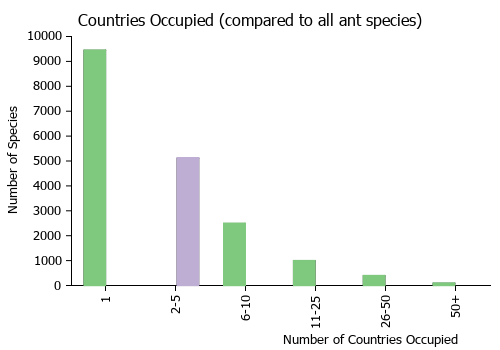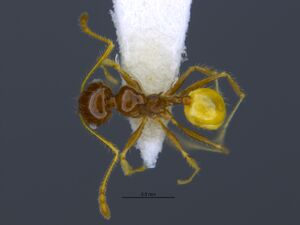Pheidole harlequina
| Pheidole harlequina | |
|---|---|

| |
| Scientific classification | |
| Kingdom: | Animalia |
| Phylum: | Arthropoda |
| Class: | Insecta |
| Order: | Hymenoptera |
| Family: | Formicidae |
| Subfamily: | Myrmicinae |
| Tribe: | Attini |
| Genus: | Pheidole |
| Species: | P. harlequina |
| Binomial name | |
| Pheidole harlequina Wilson, 2003 | |
The type colony was collected roughly in the center of Hispaniola, in a ravine with a pine-hardwood forest.
Identification
See the description in the nomenclature section.
Keys including this Species
Distribution
A Hispaniola endemic that is only known from the Dominican Republic.
Latitudinal Distribution Pattern
Latitudinal Range: 29.45847° to 18.39°.
| North Temperate |
North Subtropical |
Tropical | South Subtropical |
South Temperate |
- Source: AntMaps
Distribution based on Regional Taxon Lists
Neotropical Region: Dominican Republic (type locality), Greater Antilles.
Distribution based on AntMaps
Distribution based on AntWeb specimens
Check data from AntWeb
Countries Occupied
| Number of countries occupied by this species based on AntWiki Regional Taxon Lists. In general, fewer countries occupied indicates a narrower range, while more countries indicates a more widespread species. |

|
Estimated Abundance
| Relative abundance based on number of AntMaps records per species (this species within the purple bar). Fewer records (to the left) indicates a less abundant/encountered species while more records (to the right) indicates more abundant/encountered species. |

|
Biology
Castes
Worker
Minor
   
| |
| . | |
Major
   
| |
| . | |
Nomenclature
The following information is derived from Barry Bolton's Online Catalogue of the Ants of the World.
- harlequina. Pheidole harlequina Wilson, 2003: 432, figs. (s.w.) DOMINICAN REPUBLIC.
Unless otherwise noted the text for the remainder of this section is reported from the publication that includes the original description.
Description
Similar to Pheidole drepanon, another unusual Dominican endemic, differing from it and all other Pheidole as follows.
Major: propodeal spine thick, curved slightly, and as long as the propodeal basal face anterior to it; body multicolored as depicted and described under Color below; head much broader than long, expanding posteriorly to maximum width at occiput; a small patch of rugoreticulum present between eye and antennal fossa on each side, and most of rest of dorsal surface of head carinulate; postpetiole from above oval.
Minor: multicolored, as described below; propodeal spines thick, curved, and as long as the propodeal basal face anterior to them.
MEASUREMENTS (mm) Holotype major: HW 0.94, HL 0.90, SL 0.66, EL 0.14, PW 0.50. Paratype minor: HW 0.50, HL 0.50, SL 0.62, EL 0.10, PW 0.34.
COLOR Major: multicolored; mesosoma and waist dark brown; posterior rear half of head, a large circular patch covering part of vertex, and all of frontal triangle and clypeus medium brown; and rest of body clear yellow.
Minor: head, mesosoma, and waist dark brown; gaster pale yellow; appendages light to brownish yellow.
Figure. Upper: holotype, major. Lower: paratype, minor. Scale bars = 1 mm.
Type Material
DOMINICAN REPUBLIC (Greater Antilles): Hotel Nueva Sueza, Constanza, La Vega Prov., 1300 m, col. William L. and Doris E. Brown. Museum of Comparative Zoology
Etymology
NL harlequina for harlequin, clown in multicolored, brightly patterned costume.
References
- Wilson, E. O. 2003. Pheidole in the New World: A dominant, hyperdiverse ant genus. Harvard University Press, Cambridge, MA. (page 432, fig. major, minor described)
- Lubertazzi, D. 2019. The ants of Hispaniola. Bulletin of the Museum of Comparative Zoology, 162(2), 59-210 (doi:10.3099/mcz-43.1).
- Prebus, M.M. 2021. Taxonomic revision of the Temnothorax salvini clade (Hymenoptera: Formicidae), with a key to the clades of New World Temnothorax. PeerJ 9, e11514 (doi:10.7717/peerj.11514).
References based on Global Ant Biodiversity Informatics
- Perez-Gelabert D. E. 2008. Arthropods of Hispaniola (Dominican Republic and Haiti): A checklist and bibliography. Zootaxa 1831:1-530.
- Wilson, E.O. 2003. Pheidole in the New World: A Dominant, Hyperdiverse Genus. Harvard University Press


